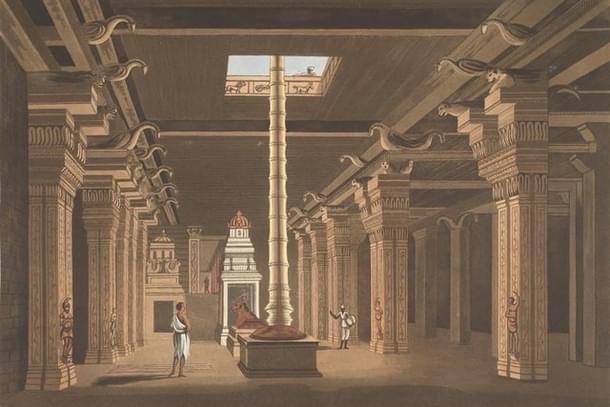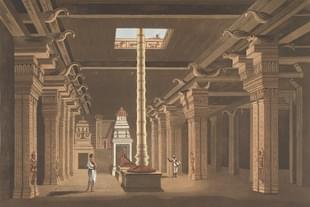Magazine
A Long, Forgotten History Of India As One Of The Most Creative Civilisations That Ever Existed
Rajeev Srinivasan
Jul 01, 2018, 01:23 PM | Updated 01:23 PM IST
Save & read from anywhere!
Bookmark stories for easy access on any device or the Swarajya app.


Creativity is one of the greatest gifts for an individual or a nation. India has possibly had the most creative civilisation that ever existed. I sometimes think that we were so extravagantly creative that we have actually forgotten more than what most other civilisations created. This aspect of India is not so well appreciated – we are satisfied with the idea that India is the Empire of the Spirit, because of its unmatched philosophical contribution to matters of the soul and spirit.
But, we seldom realise that India was also the Empire of the Intellect, the place where arguably the greatest flowering of the intellect, the greatest outpouring of creativity, happened over our long history. “The intuitive mind is a sacred gift and the rational mind is a faithful servant”: that is a quote from Albert Einstein; and it is in India that the intuitive mind perhaps has reached its zenith – and indeed, where it synchronised most gracefully with the rational mind.
Interestingly, the entire story about soaring creativity also has a very down-to-earth corollary: which is that creativity does not come in a vacuum. It is only possible in a highly civilised society, which has overcome the low-level Maslovian needs of food and shelter and has evolved to a stage where people seek self-actualisation. In other words, it was the immense productivity of Indian agriculture, and also Indian industry, that made creativity possible.
The abundance of India’s land has not been fully appreciated. A study by the World Bank notes that India has 156.4 million hectares of arable land; the US has 152.2 million; Russia 123.1, and China including Chinese-Occupied Tibet has 119. It is true that our productivity per hectare is low now (but it wasn’t so in the past, as has been demonstrated based on inscriptions in the Tamil country and British colonial records), but with better techniques, we should be able to generate a surplus.
It was, for instance, the immense agricultural productivity of the Cauvery delta that made possible the apogee of Indian art, the Chola bronzes; some of its architectural masterpieces, such as the Brihadeeswara temple; and, yes, its greatest military conquests, such as the expedition to the Srivijaya empire in Sumatra, Indonesia, exactly 1,001 years ago, in 1017 CE. Prosperity is a necessary condition for creativity, and indeed an outcome of it as well.
A recent Twitter argument about the great monumental architecture of India (in response to a brouhaha about the UP government de-emphasising the Taj Mahal in its tourism brochures) brought this fact into sharp relief: despite the ravages of time and invasion, the extant monuments in India, ranging from the ruins of Vijayanagara at Hampi to the Martand Sun Temple in Kashmir, and the step well at Modhera, Gujarat, to the elegant town-planning of the Indus-Sarasvati cities of Harappa and Lothal, all remind us of the extraordinary amount of sacred and secular construction we have here.
It also brought up another question: why haven’t we at least tried to reconstruct some of these ruins? Professor Subhash Kak, whose knowledge of both the classics and of modern science is legendary, asked a very pointed question on Twitter: he posted two photographs of the ninth century temples at Prambanan in Java, Indonesia, one from 1895 (when they were in ruins) and one from now (when they have been largely restored and reconstructed in their glory). Why can’t we, he asked, pick a few of our ancient ruins and bring them back to life as the Dutch did there?
This is a very good question. Prambanan is in an earthquake/volcano-prone region, and the tall spires of the temples (there are three, dedicated to Shiva, Vishnu and Brahma) had collapsed in piles of rubble, but when I visited in 2017, they had been put back together in some form that must approximate the original. The same is true of nearby Borobudur.
Compared to this, India neglects its own temples, wilfully and sometimes, it appears, with malice aforethought. There is a general disdain for the magnificent ruins, unlike, say in Rome, where they maintain the Colosseum with care and respect.
But if you go back to art in general, the sacred art of India has been a form of worship for millennia: the extraordinary sculpture that has survived (while paintings have largely disappeared) shows that there is a remarkable continuity from the ear liest days of the Indus-Sarasvati, and an appreciation of the human figure. There is also continuity in styles as well as the emotional underpinnings – i.e. rasa or the inducement of emotions – in the viewer, the rasika. For instance, the poised and graceful female figure with one hip bent, the right hand raised, and one leg slightly forward is a standard meme in sculpture across the ages and a unique Indic meme.
The soft power of these Indic ideas meant that they became popular across a large swathe of territory, with little by way of military conquest. Many people saw that the Indic ideas were good and useful, and therefore adopted them. For instance, consider Southeast Asia. The great Hindu civilisations of Indonesia were established by sailors from Kalinga; Odiyas still celebrate their Bali yatra which was on 5 November last year, remembering the arduous journey. And, as is well known, Bali continues to have an exuberant Hindu civilisation, of which one of the highlights is the beautiful water temple at Pura Ulun Danu Bratan.
But it was not just religious ideas that were exported. The very languages of Thailand, Cambodia and Vietnam were influenced by Devanagari and Sanskrit: to this day, their scripts look Indic (though some have shifted to Roman) and their languages (“Bahasa”, from bhasha) still have the familiar aa-ee-oo vowels of Indian languages. Much of the vocabulary of Malay, Indonesia Bahasa, is still derived from Sanskrit, although Arabic words are becoming more prominent.
The architecture of Southeast Asia was for centuries dominated by Indic ideas. Not surprisingly, the world’s largest religious structure is the former Hindu temple of Angkor Wat in Cambodia, an immense structure that is astonishing in its magnificence. The largest structure in the entire Southern Hemisphere is the giant hill of Borobudur in Java, a powerful re-construction of the many-layered Buddhist universe.
The echoes of Indic ideas still linger in Southeast Asia, and at a time when Association of Southeast Asian Nations is likely to become a bigger player in the (newly-minted) “Indo-Pacific”, it would not be a bad idea for India to attempt to revive the old term for the region: “Greater India”. As recently as the 1970s, that term was current. With the likely rise of India and the grand narrative that India will naturally articulate, it would be invaluable for geo-political purposes to try and build on the commonality. A long-delayed visit by Prime Minister Narendra Modi to Indonesia, and the proposed joint development of a port in Sabang, Sumatra, at the mouth of the Straits of Malacca and close to the Andamans, may well be a first step in reviving this connection.
But it was not only to Southeast Asia that Indic ideas spread: it was also to East Asia and West Asia. To this day, there are Japanese Buddhist sects that write their sutras in Sanskrit in the Siddham script, a derivative of Brahmi, and a precursor of the Tibetan script. The 12-year Chinese zodiac is derived from Sanskrit words and concepts.
In Mesopotamia, the Mitanni empire of roughly 1500 BCE had kings and nobles who apparently used a variant of Sanskrit: their treaties include Indic deities and other Indic cultural markers. The story of the Indian decimal system, which Arabs knew as Hindu numerals, and Europeans as Arabic numerals, is too well known to repeat.
A great deal of Indian mathematics, philosophy, technology and medicine found its way into West Asia and further west to the Greeks. A couple of examples will suffice: wootz, the nano-carbon steel from southern India (the name comes from the Tamil urukku, steel) that was known as ‘damascene’ to the Crusaders, because they thought it came from Damascus, Syria. The Greek terms for constellations are the same as those in Sanskrit. Unfortunately, westerners have by default always assumed that everything worth creating has come out of Greece and Rome (or China) and found its way to India, and never the opposite; so we have been denied the credit for inventing them.
Innovation and creativity have real value in the marketplace. One of the main reasons American culture has become accepted the world over as the most appealing is its creativity (and the means to spread it): Hollywood, Silicon Valley and Wall Street, all have been highly innovative, and they have become the envy of the world. In almost exactly the same way, ancient India was able to become the most attractive culture in the world, and people used to travel a long way to India to learn about all the tremendous things that had been discovered and invented here. It bears repeating that Indian universities were among the earliest and best in the world.
The list of India’s innovations is long: Panini’s grammar, Aryabhata’s astronomy, Madhava’s infinite series, Kanada’s atomic theory, Brahmagupta’s articulation of the zero, and so on. In fact, a case can be made that India’s greatest comparative advantages lie in two areas: agriculture and intellectual property generation. Intriguingly, it is precisely these two that have been respected the most in our culture, as represented by the cow and the Brahmin. Sadly, we have fallen behind in both areas.
In past columns in this series, we have looked at the latest innovations in various fields. In some future columns, we will consider ancient innovations that, alas, are not well known to Indians; and they are, therefore, prone to being digested and absorbed into the Western canon. Besides, the seeds of our future lie in our past.
Rajeev Srinivasan focuses on strategy and innovation, which he worked on at Bell Labs and in Silicon Valley. He has taught innovation at several IIMs. An IIT Madras and Stanford Business School grad, he has also been a conservative columnist for twenty years.





